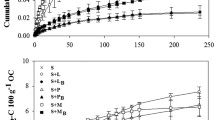Abstract
Soil amended with different organic inputs or biochar types was analysed by Fourier transform infrared (FTIR) microscopy. Changes in the chemical composition were observed through variations in the spectra and were consistent with changes in carbon dioxide release. Biochar addition strongly decreased the concentration of polysaccharides which was well related to low rates of carbon respiration. Forest waste also induced a low increase on carbon respiration while preserving a high ratio of aromatic carbon in soil. Otherwise, soil amendment with maize straw increased carbon respiration circa ten times while reducing the signal of aromatic carbon. Overall, the results suggest that aromatic compounds and polysaccharides largely determine carbon respiration rates in soil.
Access provided by Autonomous University of Puebla. Download conference paper PDF
Similar content being viewed by others
Keywords
Introduction
The application of organic amendments to soil aims to improve soil quality and promote sustainable crop production. However, the turnover of organic inputs and native organic matter (OM) in soil is still poorly understood. Thus, an accurate estimation of the effects on soil respiration remains elusive (Six et al. 2002). This gap of knowledge is attributed to methodological restraints that hamper disentangling the complexity of the chemical composition and distribution of soil OM.
Fourier transform infrared spectroscopy (FTIR) is a suitable tool to characterize the functional groups of OM and their distribution in soils (Lehmann et al. 2007). This study aimed to gain a better understanding of the relationship between carbon respiration rates and changes in OM composition in soil.
Materials and Methods
Soil samples were collected from the topsoil (15 cm) of an agricultural field in Belgium without disturbance. The soil presented a background content of OM 2.3%, pH 7.1 and estimated texture 35/53/12 (sand/silt/clay). Undisturbed subsamples of soil were amended with either forest waste (FW), peanut shell (P), fresh (Mf) or dry (Md) maize straw. A second set of samples was added with biochar, prepared in a furnace oven (450°C) using FW, P, Mf or Md as feedstock (FW-B, P-B or M-B) according to Kookana et al. (2011). A third subset of samples was amended with a mixture Md + M-B.
The soils were then incubated at 25°C in the darkness, and CO2 released was measured at 3 (t1), 5 (t2) and 10 days (t3) using a LI-820 CO2 analyser (Bouillon et al. 2008). After 10 days, samples were collected and analysed with an FTIR spectrometer Agilent 600. Spectra presented were obtained as the average of five spectra. Distribution of polysaccharides on soil microaggregates was confirmed by confocal laser scanning microscopy (CLSM) using an Olympus IX81 microscope equipped with a Fluoview FV1000 confocal scanning unit.
Results and Discussion
FTIR spectra for the organic amendments (Fig. 1) showed the consistent presence of polysaccharide-C (1,035 cm−1), aromatic-C (1,600–1,900 cm−1) and aliphatic-C (2,900 cm−1), in FW, P and Mf (Fig. 1). Lowest signal intensity was observed for Md.
The spectra collected for the biochar samples (Fig. 2) indicated that biochar provides a source of carbon with no or only a slight content of aromatic compounds and polysaccharides, regardless the feedstock.
Variations in the chemical composition of soil OM upon incubation with the different organic inputs are summarized in the spectra presented in Figs. 3 and 4. Overall, a lower intensity of the signal at 1,200–1,500 cm−1 can be related to a decrease in polysaccharides concentration in the pool of organic matter, particularly significant for soil amended with biochar (Fig. 4).
Variations in the spectra were consistent with carbon respiration rates (Fig. 5). Thus, soil amendment with FW did not result in a significant change in the spectra or the respiration rate, while Mf addition significantly increased respiration rate while strongly decreasing the signal at 1,200–1,500 cm−1. Addition of the mixture Md + Md-B resulted in similar spectra than Md but higher respiration rates, suggesting a synergic effect. Lower intensity of the peak around 1,200 cm−1 was consistent with a decrease in respiration rates.
Carbon respiration rates were also related with the distribution of the different chemical compounds in soil microaggregates. For soil amended with Md, microaggregates exhibited a homogeneous distribution of polysaccharides on the surface of the microaggregates (Figs. 6 and 7), while aromatics were found only in specific locations (Fig. 7).
Molecular analysis of soil organic matter composition allows defining discrete pools that can be linked with carbon respiration rates. Preliminary results point to polysaccharides and aromatic compounds as main drivers of organic matter turnover in soil.
References
Bouillon, S., A.V. Borges, E. Castañeda-Moya, and K. Diele et al. 2008. Mangrove production and carbon sinks: A revision of global budget estimates. Global Biogeochemistry Cycles 22(2), GB2013, doi:10.1029/2007GB003052.
Kookana, R.S., A.K. Sarmah, L. Van Zwieten, E. Krull, and B. Singh. 2011. Biochar application to soil: Agronomic and environmental benefits and unintended consequences. Advances in Agronomy 112: 103–143.
Lehmann, J., J. Kinyangi, and D. Solomon. 2007. Organic matter stabilization in soil microaggregates: Implications from spatial heterogeneity of organic carbon contents and carbon forms. Biogeochemistry 85: 45–57.
Six, J., R.T. Conant, E.A. Paul, and K. Paustian. 2002. Stabilization mechanisms of soil organic matter: Implications for C-saturation of soils. Plant and Soil 241: 155–176.
Author information
Authors and Affiliations
Corresponding author
Editor information
Editors and Affiliations
Rights and permissions
Copyright information
© 2013 Zhejiang University Press and Springer Science+Business Media Dordrecht
About this paper
Cite this paper
Hernandez-Soriano, M.C., Kerre, B., Horemans, B., Smolders, E. (2013). FTIR Analysis of Soil Organic Matter to Link the Turnover of Organic Inputs with Carbon Respiration Rates. In: Xu, J., Wu, J., He, Y. (eds) Functions of Natural Organic Matter in Changing Environment. Springer, Dordrecht. https://doi.org/10.1007/978-94-007-5634-2_7
Download citation
DOI: https://doi.org/10.1007/978-94-007-5634-2_7
Published:
Publisher Name: Springer, Dordrecht
Print ISBN: 978-94-007-5633-5
Online ISBN: 978-94-007-5634-2
eBook Packages: Earth and Environmental ScienceEarth and Environmental Science (R0)











